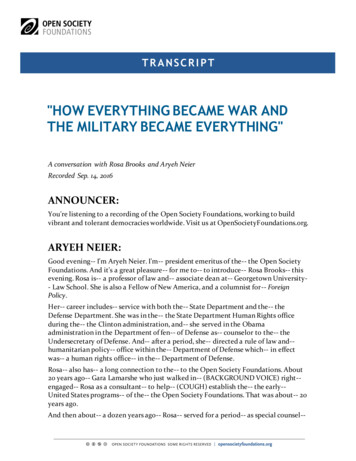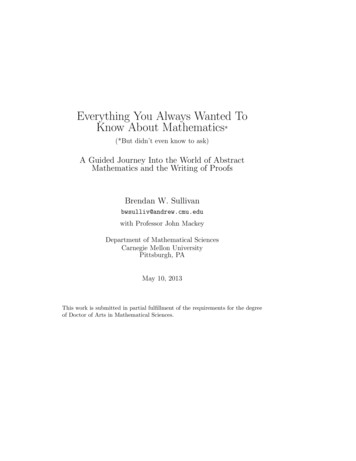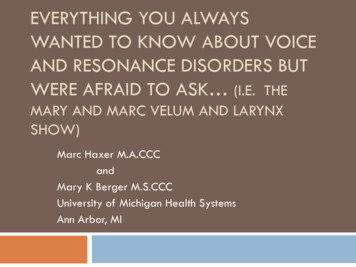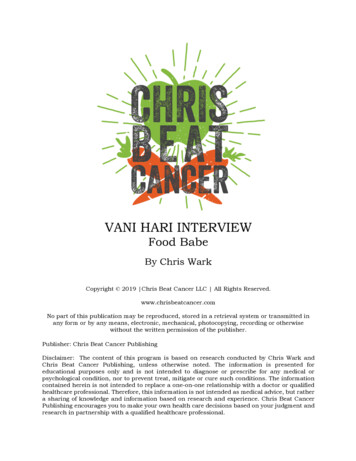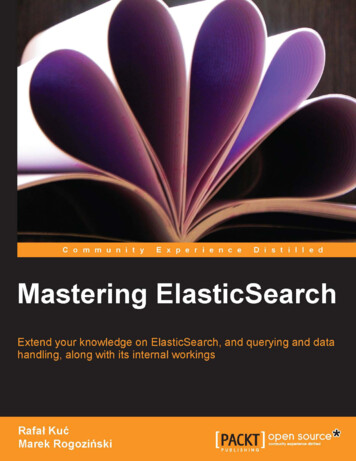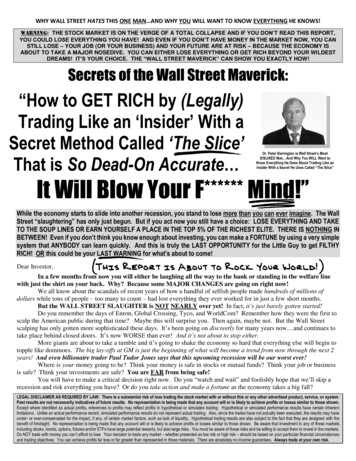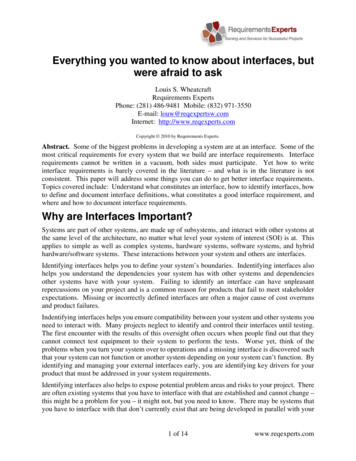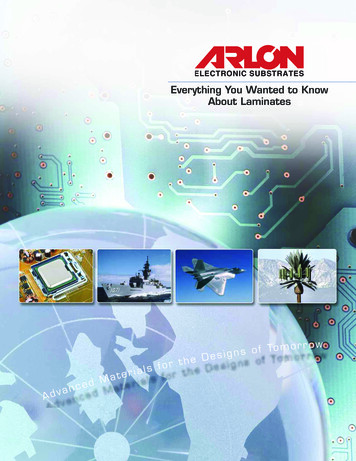
Transcription
ELECTRONIC SUBSTRATESEverything You Wanted to KnowAbout Laminatesthe DrofialsretMadeancvdATo m o r r o wfosnesig
“Everything You Ever Wanted to Know AboutLaminates, But Were Afraid to Ask” 10th EditionIntroduction to the “FAQ” EditionDear Browser,It has been almost 30 years since the earliest edition of “Everything You Ever Wantedto Know About Laminates but Were Afraid to Ask” was pounded out on an old TRS80 (Trash 80) Computer. It has undergone periodic review and editing, includingadaption for use on our website. (When I entered the industry Al Gore had not yetinvented the internet.) Before I “retired” in 2004, we did another minor revision, but itwas largely cosmetic, removing most references to the old military specification andintroducing IPC-4101, the “new” IPC specification for laminate and prepreg materials.In 2009-2010 we did a total review, editorial rewrite and facelift. The 9th Editionincorporated not only the fundamentals which have not changed in 25 years, butrecognized that the industry had moved a long way over the previous 5 years, and Arlonhad a much more diversified line of high performance products serving a marketplacewith evolving needs and priorities. Yes, we still are the premier manufacturer ofpolyimide laminate and prepreg -- and still supply a variety of materials for CTE control.But we also make a family of low flow materials, a line of thermally conductive materialsand have entered the arena of lead-free and “green” products, to mention a few. Whatwould have been considered a “high tech” multilayer board 25 year ago is beingproduced routinely now, and high tech has become altogether different and morecomplex. We tried to reflect a changing world in the 2009 9th Edition, and we continueto update in this 2013 10th (FAQ) Edition of “Everything ”When I entered the laminates industry in 1983 (when Arlon acquired Howe Industries) Iknew almost nothing about the industry or the application of its products. It was a highintensity learning curve for me, with a lot of help from internal gurus and from ourcustomers, who were always willing to share their knowledge and experience. I had toask a million questions (usually several times) before I started to feel comfortable withit all. The original idea behind Everything ” was to answer the many questions ourcustomers asked about high tech materials – which in large part turn out to have beenthe same ones I had asked for myself in my first few months in the industry. It woundup being a “best seller” and we “sold out” several early print editions. (The price wasright, of course!)It would be impossible to personally thank everybody who has contributed to“Everything ” through the years, but in particular I want to mention Vince Weis, ArlonTechnical Service, my mentor when I first entered the industry, and still my “go-to guy”when there is a question to which I don’t have an answer.I dedicate this 2013 FAQ Edition of “Everything ” as in 2009, to my many Arlonco-workers, industry peers and customers, so many of whom have been generous withtheir advice throughout the years, and without whom there would never have been an“Everything ” and with special kudos to Sandy Little, Arlon’s Sales and MarketingCoordinator, who provides the aesthetic and practical skills to make and maintain theFAQ Edition a working reality.In addition to this full downloadable pdf file, all the material in the 10th Edition is on-lineat Arlon-med.com in the Technical Literature section under FAQ’s!Chet Guiles,Rancho Cucamonga, CAOctober, 2013
Table of ContentsI. MATERIALSHow are PWB Laminate Materials Classified? 8Is there an "Ideal" PWB Material or system? 8What Do We Need to Know About Epoxy Resins 11What do we Need to Know About Blended Resin Systems 11What are Polyimides and Why are They Used in PWB Laminates? 12What are Non-Traditional Resin Systems 12What are Some Typical Polyimide and Epoxy Products (Arlon Systems) 13How Do We Define High performance in Terms of PWB Materials? 14Define Glass Transition Temperature (Tg) and discuss its significance 14What determines "Continuous Operating Temperature" of a system 16Why do epoxies and polyimide turn brown when we exposethemto elevated temperature? 16Do resins require a postcure after laminating? 17Can we cure polyimide at 360 F without a postcure? 18What are Dielectric Constant and Loss Tangent? 18What is Impedance? 20How do you calculate impedance? 20Given the normal variability in materials and process, can you design aroundthe laminate dielectric properties you can get from your PWB manufacturer? 21What is the importance of the copper foil used on laminates? 21What is the difference between "rolled" and electrodeposited foil?How do you know which one to use for a given job? 22What is Copper Foil Treatment? 22What is Ohmega-Ply ? What is its application? 23What is HTE Copper? Why do we use it? 23What is Copper-Invar-Copper (CIC)? Why do we use it? What are its limits? 23What is Release Copper? Why do we use it? 23How is copper affected by Tg, operating temperature, etc.? What factors 24contribute to copper bond longevity?What governs the choice of which copper foil type or weight to use in a 24particular laminate?What Kinds of Reinforcements are Used in PWB Laminates and Prepregs? 25What are the differences between the common fiberglass fabric stylesused in laminates? What is the basis for their choice and selection? 25What are "Warp" and "Fill?" What other terms are used to describe thedirection of weave in fabric? Why is this important? 26What is "Weave Distortion?" What problems can it cause? 27What is S-Glass and why would we use it? 27What is Kevlar ? Where do we use it? 27What are the differences between quartz and standard E-glass?Why is quartz so expensive? When would we use it? 27What is Thermount ? (aka Nonwoven Aramid) 28
II. PREPREGWhat is Prepreg? Briefly, how do we produce it? 29What is gel time? Why does IPC-4101 make gel time an "optional" test? 29What is resin content? Why is it important? How do we test for it and control it? 29What is flow? How do we test for and control it? Why is it important? 30What is Scaled Flow? How do we measure it? What does it tell us? 31Are there other flow test methods that may be more useful than the traditionalMil Flow and Scaled Flow tests now most widely used in the industry? 31What is ODR Used for? 32Why do we Need to Understand Rheological Testing? 32What are "No-Flow" (more accurately “Low-Flow”) Prepregs? 32What are the most common problems customers will encounter with prepreg?What do we need to know to help resolve those problems? 33How do we know what the "Shelf-Life" of various prepregs should be?What are the shelf life requirements for polyimide prepregs? 34Tell us more about moisture issues in prepreg? 34What about polyimide prepregs? Is moisture really a bigger issue withpolyimides than with epoxy systems? 34Why does Arlon recommend vacuum desiccation of all prepregs prior to use. 35III. LAMINATEWhat is a Laminate? 35How Are Laminates Classified? 35What are the Most Important Laminate Properties? 36What is MIL-S-13949? 36What is IPC-4101? 37How Do I read an IPC-4101 Slash Sheet?How does our part number relate to the IPC-4101 line callout?Why can't we just use that callout as an internal part number? 38What testing does IPC-4101 require us to do? 39What is a QPL? 40What determines the thickness of a laminate? What do we mean by "buildup"? 40What thicknesses can we build and what buildups are typical of standard products? 41Why don't we recommend the use of single side clad laminate for use as cap sheetson multilayer boards? 41How does measurement of thickness by cross-section differ from measurement ofthickness by micrometer? What difference does it make? 42What are the IPC-4101 requirements for thickness tolerance? How do we definethem? Can we meet them all? 43Can we get Special Thicknesses, Tolerances? 43What are the "X", "Y" and "Z" axes of a laminate? What is their significance to ouruse of laminate? 44What is the significance of UL Recognition of polyimide laminates? 44What is a Cert? 45What do we include in a Cert/Test Report? 45How do we control traceability? 45What is IPC-4103? 45
IV. PROCESSINGHow can a laminator be of assistance to its customers in defining processes orproviding process information? 46What are the limitations of laminator-supplied processing recommendations? 46What are the “critical” process parameters that we need to be aware of? 47At what points in the manufacturing process must changes be made inhandling high performance resins (i.e. polyimide and others) vs. FR-4? 47What special precautions must be taken with regard to moisture in highperformance polyimide and some multifunctional epoxy prepregs? 48Talk to me some more about oxides? Why shouldn’t we use the traditional blackoxide? The lighter red or brown oxides don't look right? 49What will be the biggest problems with oxiding? 49What Are “Oxide Alternatives”? 50What press cycles should we use for MLB lamination? 50What do we have to do to ensure that our product is properly cured? 51Why is the rate of heat-up critical? 51What issues might I encounter with out-of-norm pressure? 52How do I control prepreg flow? 52Why is vacuum lamination superior to conventional press lamination for highperformance multilayers? How does it differ? 53We have heard a lot about dimensional stability. How can we get materials that aredimensionally stable? 53How is Dimensional Stability Characterized? 53Does Laminate Construction Affect Registration? 54What Methods are Available for Enhancing Registration? 54What determines drill speeds and feed rates? What are the best drillingconditions for use with polyimides? 55Why can’t I punch my polyimide boards? 55We hear a lot about Lead-Free Solder processing. What effect will highersolder temperatures have on my MLBs? 56How about processing Woven Kevlar Materials? Are there any specialprecautions to take while processing aramid fiber reinforced boards? 56Are there any problems drilling or routing Kevlar ? 57How about Thermount? What are the process issues we will encounter withThermount reinforced laminate systems? 57V. CONTROLLED CTEWhy is the CTE of a MLB so important? 58What is CTE (Coefficient of Thermal Expansion)? 58Can we find CTE-Controlled Products in all Resin systems? 59What are the CTEs of the materials used in making MLBs? 59What is the CTE of a typical multilayer board? 60What are the available solutions to the CTE mismatch problem? 60Is there a "correct CTE" for a surface mount MLB? 60Why is the coefficient of thermal expansion of the laminate always greater in theZ-direction that in the X and Y axes in the plane of the laminate? 61Discuss the issue of total Z-direction expansion 50 to 260 C 61
What is The Schapery Equation? 62You mentioned an 0.006" CIC product. Tell us about that.How do we use it? Are there any limitations? 62How is Copper-Invar-Copper used? 63Is CTE the only reason for the use of a metal core in a PWB?Does the use of metal cores raise other issues? 63Sounds like a lot of issues with CIC. Are there solutions for any of them? 64What is Howefill 50 ? How do we use it? 65When Would I use a Ceramic Filled Prepreg? 65Talk to us about woven aramid reinforced PWBs.What are the advantages of this system? 65Does Use of Woven aramid Reinforced Laminates have any disadvantages? 65There is still interest in quartz fabrics for CTE control. Why? 66Are there disadvantages of quartz fabric? 67Talk to us about Thermount? It looked like the ideal balance ofcost/performance for Surface Mount PWBs. Where does that all stand? 67What is the downside of nonwoven aramid, if any? 67So what is Arlon doing about the nonwoven aramid supply issue? 67VI. ANALYTICAL METHODSWhat Analytical Methods are used in the PWB Laminates Industry? 68What is Thermomechanical Analysis (TMA) and why is it used? 68Can you define Tg in terms of TMA measurement, and discuss its significance? 69What is Differential Scanning Calorimetry (DSC)? 70What does DSC tell us about the resin systems we use in PWBs? 71Why do we use TMA instead of DSC to measure the Tg of polyimide systems. 71What is TGA (Thermogravimetric Analysis) and what do we learn from it? 72What is IR? (Infrared Spectrophotometry) 73What is Rheology? 73What kinds of flow (rheological) testing are available and whatinformation do they provide? 74What does rheological characterization mean to you? 74What is a Parallel Plate or Oscillating Disc Rheometer (ODR)? 75How does the ODR present this data? 76What is Cone & Plate Rheometry? 76How do we measure Thermal Conductivity? 77What is the Importance of Thermal Conductivity? 77How do we Measure Dielectric Constant and Loss Tangent?What Mechanical Properties are Considered Important in PWB Materials? 78
I. MATERIALSHow are PWB Laminate Materials Classified?The popular names of the materials which comprise the majority of printed wiring board laminates have oftenbeen generalizations of the chemical names of the principal resin systems used in each, such as "Epoxy," "Polyimide,” "PTFE" and the like. In recent years the search for products suitable for evolving high performance applications have resulted in the use of new materials and combinations of materials that make the generalizationsof the past somewhat more difficult to sustain. For instance, reference to “Epoxy” or “FR-4” is too general toaccommodate the diverse requirements that characterize Low Flow, Multifunctional, Lead-Free, CAF Resistant,High Speed Digital and “Green” epoxy products. This diversification is reflected in the proliferation of slashsheets in IPC-4101, the laminate and prepreg spec currently in effect in the industry. (IPC-4101 is discussed insome detail in section III, “Laminates.”) Products can also be characterized in terms of intrinsic properties, resinsystem, end application or even substrate type.Some of the newer products, such as those based on laser drillable fiberglass, woven Kevlar ,Thermount nonwoven aramid substrate or woven quartz reinforcement are frequently referred to by the genericname of the substrate rather than by the resin utilized, and of course all laminators including Arlon would like tohave you all use our trade names rather than generic resin designators! (Naturally that would preclude you fromreferring to them by our competitors' trade names.)Many of the resins in use in the electronic laminates industry are thermosets (which means that they "cure" intoa hard final product) rather than thermoplastics (which may be melted and re-melted). The most notableexception of course is the use of PTFE, or polytetrafluoroethylene (also known by its DuPont trade name asTeflon although DuPont is not the only manufacturer of PTFE) in laminates for microwave and RF, where itsdielectric properties are ideal for high frequency applications.Is there an "Ideal" PWB Material or system?If not, what would be the key elements of such a system?Because of the diversity of materials available and the wide range of applications, the concept of an “ideallaminate” has become fuzzy, to say the least. A material ideal for a high temperature application may beimpractical in a microwave or high speed digital design, for instance. As a result, while we can list propertiesthat are potentially important, each design team needs to establish a prioritization among them because no onematerial will have the optimal value for all the properties which might be considered important. Your laminate“cookbook” does have some common “ingredients” (i.e. properties) from which designers will be making choicesduring the design phase:Glass Transition Temperature (Tg): The highest temperature systems are polyimides (such as Arlon’s 35N, 33Nand 85N) with Tgs of 250 C or above. Tg is a rough indicator of total Z-direction expansion and hence isconsidered a proxy for plated through hole reliability. A wide variety of epoxy systems in the 160-170 C rangehave found application where either process temperatures or in-use temperatures (or both) are less demanding.While Tg is a good frame of reference for traditional epoxy and polyimide materials, it is less reliable for reliabilitycharacterization of highly filled systems and for many of the non-traditional resin systems used in highfrequency/low loss applications whose properties are composites of their various components.Example: Polyimide Thermount MLBs will survive 2-3x the thermal cycles of standard polyimide glass despitehaving identical resin and Tg because there are no stress concentrators caused by fiber bundles intersecting thewalls of the plated through holes.8Example: A filled PTFE product such as Arlon’s CLTE-XT microwave material does not have a Tg in the rangeof 50 to 260 C (PTFE does not exhibit a glass transition such as is seen in thermoset materials and its meltpoint is well above the use temperature range) but because of the low expansion filler, has a low and consistentZ-direction expansion in that range by virtue of which it will have excellent plated through hole reliability.
T260, T288 and T300 values represent the length of time that a clad laminate will survive a particular temperature(respectively 260 C, 288 C and 300 C) before it begins to delaminate or blister. The test is performed in a TMA(Thermo-Mechanical Analyzer) and these values are considered good indicators of the short term resistance ofproducts to solder processing; as such, they have become part of the Lead-Free minimum requirements asdefined by IPC.Thermal Decomposition Temperature (Td): This property varies greatly with the chemical composition ofmaterials, from the mid 300 C range for many epoxy systems to over 400 C for some polyimides. Td is thetemperature at which a material begins to degrade thermally. Some data sheets will list a Td as the temperatureat which a material has lost 5% of its original weight due to decomposition. A better indicator of performancewould be the onset temperature, at which significant weight loss begins to occur. By the time a material, haslost 5% of its weight to decomposition it may well be unusable in many applications.Dielectric Constant and Loss Tangent: Dielectric constant determines the speed at which an electrical signalwill travel in a dielectric material. Signal propagation speed is expressed relative to the speed of light in avacuum, which is roughly 3.0 x 10 cm/sec. The dielectric constant of a hard vacuum (space) is defined as 1.00.Higher dielectric constants will result in slower signal propagation speed. Loss Tangent is a measure of howmuch of the power of a signal is lost as it passes along a transmission line on a dielectric material.These are determined by the inherent properties of the components of any specific resin system, although wenormally refer to a “relative dielectric constant” because it is dependent on test method and frequency as wellas material per-se. No one value of Dk is “ideal” for all applications. For many high speed digital applications,modified epoxy systems with dielectric constants in the range of 3.0 to 3.5 have been found to offer goodcost-performance value. In other applications such as critical antennas, low noise amplifiers, etc., a very lowloss material such as PTFE is optimal. Choice of specific material is as much driven by loss characteristicsunder use conditions as it is by the nominal Dk. For microwave and RF applications, pure PTFE on a fiberglasssubstrate, with a Dk of 2.1 and Loss of 0.0009, is the best available in wide commercial use. Consistency ofdielectric constant is important for maintaining designed characteristic impedance (Zo) values.Registration (aka “Dimensional Stability”): All laminate materials to some degree on etching, and the key toproper registration is consistency both of product and process. The most suitable material would be one thatmoves minimally when it is etched, and has consistent and reproducible movement that would allow predictablefactors for artwork compensation. The “ideal” material would not require artwork compensation at all, andwould always register properly so as not to require drill compensation. The IPC test referred to as “dimensionalstability” has at best a tenuous connection to the actual registration of a specific board design. Registrationcontinues to be a key fabrication requirement for high layer count and HDI designs.Coefficient of Thermal Expansion (CTE, expressed in ppm/ C): CTE should be roughly matched to theexpansion requirements of claddings, devices to be mounted on the surface and thermal planes buried in theinterior. Current thinking says that for leadless ceramic chip carrier attachment, 6.0 ppm/ C is ideal. (At present,Arlon’s 45NK woven Kevlar reinforced laminates with relatively low resin contents come closest to the 6.0 CTEideal.) Other materials such as quartz reinforcement, Copper-Invar-Copper distributed constraining planes andnonwoven aramid reinforcement achieve values as low as 9-11, a substantial improvement over 17-18 forconventional epoxy or polyimide laminates, and have proven acceptable and consistent in a variety of SMTdesigns.Thermal Conductivity (Tc): As the density of components on a board increases due to demand for increasingfunctionality, and the overall surface areas of PWBs decrease, the watt-density of power being generated on aPWB increases. Critical devices exhibit failure rates that double for every 10 C of temperature increase, and sothere is a push to have the thermal conductivity of the PWB materials themselves be high enough to help removeheat from devices on the surface of the board, without at the same time suffering in terms of electrical anddielectric properties. Target thermal conductivities to achieve significant reduction in board surface temperaturesnear active devices fall in the 1.0 to 3.0 W/m-K range, significant when compared with values of 0.25 to 0.3W/m-K for traditional epoxy or polyimide systems. Arlon provides a number of thermally conductive thermoset9
materials (such as 91ML at 1 W/m-K and 92ML at 2 W/m-K) as well as thermally conductive microwave materialssuch as TC350 and TC600.Z-Direction Expansion: Ideally the Z-direction expansion should match that of the copper in the plated throughholes (about 17 ppm/ C) to avoid damaging the plated copper during thermal excursions resulting from processsteps such as solder reflow. Most standard materials have CTEs of 50-60 ppm/ C below the Tg, and roughly 4xhigher above the Tg. High Tg materials such as polyimide have less overall Z-direction expansion (about 1.1%from 50 C to 250 C) than typical epoxy systems (with about 3 to 4% from 50 C to 250 C) due to their higherTg.Lead-Free Compatability: Lead-Free materials are materials able to withstand the higher soldering and reflowtemperatures of lead-free solder systems. These may be anywhere from 30 C to 50 C higher than traditionallead-tin systems. Lead-free systems are usually characterized in terms of Tg ( 155 C), T288 and T300 thermalresistance, Td ( 330 C to 5% decomposition) and overall CTE ( 3.5%). Materials such as polyimide havealways been “lead-free” compliant, but newer generations of epoxy systems have had to be developed to meetthe newer requirements. Lead-free is more complex than it might seem, since many current laminate materialswill survive in “lead-free” applications, while some of the devices that are mounted on the boards have not evenbeen tested at the higher lead-free temperatures. The overall thrust is to provide materials that will have a“margin of safety” across a range of higher lead-free solder temperatures.CAF Resistance: Copper Anodic Filament (CAF) growth between adjacent plated through holes can causeelectrical shorts and intermittent performance in PWBs when a combination of ionic residues, physical pathway(such as a separation between resin and an individual fiberglass fiber) and a steady voltage differential betweenholes drives the deposition of electromigrated copper along a glass fiber. CAF is of particular interest todesigners making large high performance boards that will be in use continually for long periods of time such asin high end servers. Realistic “specifications” for Pass-Fail have been difficult to define, and CAF issues can beas much related to board fabrication as to material choices. Laminators have found that proper resin formulation,engineered glass finish technology, and optimized processing can increase resistance to CAF formation.“Green” Laminate and Prepreg: The “green” requirement is driven as much by market considerations as by“good science.” Green materials are broadly defined as materials with UL-94 V0 flammability ratings achievedwithout the use of brominated flame retardants. Even though the brominated bisphenol-A that is used in mostconventional FR-4 systems is NOT “banned,” non-governmental organizations (NGOs) such as Greenpeace, arepressuring to have “green” systems become the norm and hence are trying to force a move to non-brominatedsystems wherever possible. Some like to refer to non-brominated systems as “environmentally friendly,”although little long term work has been done to-date to assess the actual health or environmental impact ofphosphorus compounds and other non-brominated systems.Modeled on the European Union’s RoHS (Recycling of Hazardous Substances) and WEEE (Waste Electrical &Electronic Regulation), many countries (and even individual states) have enacted or are in the process ofdeveloping regulations concerned with the content of electronic materials. To some degree this is a sort oftechnical minefield, because even if the various regulations are “normalized,” the cost of compliance to multipleindependent and different regulations may become a significant part of the cost of a finished PWB.Uncomplicated Processing: The “ideal” laminate and prepreg system should be able to be processed usingconventional photo-imaging methods, etching and wet chemical processing and lamination techniques. Highprocess yields and process and design flexibility should be such that the material can be used in multiple designswith high probability of success. Unfortunately much of the industry still defines “normal process” as beingthat for conventional FR-4 and has tooled for that. Use of advanced materials in high performance MLBs willrequire some rethinking of what is “ideal” processing.10
What Do We Need to Know About Epoxy Resins?By far the most common resin systems used wor
complex. We tried to reflect a changing world in the 2009 9th Edition, and we continue to update in this 2013 10th (FAQ) Edition of “Everything ” When I entered the laminates industry in 1983 (when Arlon acquired Howe Industries) I knew almost nothing about the i
